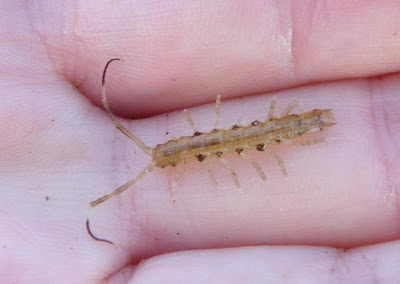Armed with buckets, trays and nets are veritable army of young explorers were encouraged to search out as many different shells and other living, or at least was once, matter. The safari set about dispelling the myth that the beach is a just a sandy expanse of nothing.
Before long the carrying net was bulging with ‘treasure’ plucked from the sand. Once we reached the surf the sampling nets were eagerly and expansively deployed. Large numbers of Brown Shrimps were hauled in along with a rather weenie Prawn and a tiny little fish, possibly a Blennie. To be honest I’d never heard of Iphinoe (I. trispinosa) before, yet countless thousands are living quietly in the sand only a few hundred yards from my desk at work.

The predatory antics of the Moon Shell were appreciated by the young audience to the cries of ‘euuchh’ as they learned how the animal drills its way in to another shell and sucks the dissolved innards out. There were plenty of shells on the beach showing the tell-tale small hole indicating the attack of the killer Moon Shell.

White Piddock shells aren’t at all that common but being so chalky white they are easy to spot.
A good selection of all sorts of shells was found.
As the tide was coming in one of our eagle eyed spotters saw this Masked Crab emerging from the sand, perhaps a couple of minutes too soon.

If we hadn’t have picked him up, it is a him – look at the length of those pincers – a seagull (no such thing - thay all have 'proper' names!) would have done and that would have been curtains for him.
The seaweeds included the Lancashire Biodiversity Action Plan species Knotted Wrack .

and one which we learned wasn’t actually a seaweed but a colony of tiny plankton feeding animals, a Bryozoan, called Hornwrack. Can you guess which one it is?

That’s right the colourless in the one centre. It’s colourless because being an animal it doesn’t photosynthesise.
Also in there is the obvious to spot Purple Laver which is the ingredient for the Welsh dish Lava Bread. My favourite is the bright green one bottom left, Enteromorpha intestinalis, or Gutweed, so called due to its flimsy tubular structure.
Altogether we found almost 40 species in the walk out to the tide and back amongst the holiday makers. A pretty good morning’s safari. The rest of the hundreds of people enjoying the sunny beach probably had no idea there was so much wildlife to be discovered under their feet. If only they’d looked more closely at this ‘devoid of life desert of sand’.
Where to next? More of the same tomorrow but this time we’re heading north on Central Beach rather than south. Will it be the same creatures or will there be significant differences?
In the meantime let us know what’s lurking in your deserted desert outback.



2 comments:
Great stuff! I often notice the different little critters underfoot on the beach, but I'm pretty close to clueless as to what they are.
Fortunately we had a resident expert from the Fylde Coast Marine Life Project (see links on right) who joined us on this event to rummage out and identify the more unusual stuff. Otherwise I mostly wouldn't have had a clue. But it does go to prove there's lots out there if you just take a little time to look.
Dave
Post a Comment